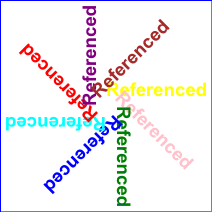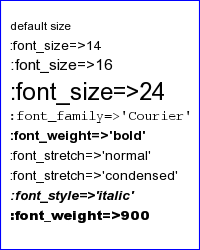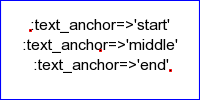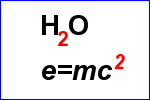class RVG::Text <
Object
Table of Contents
class methods
instance methods
shared methods
In addition to the methods listed above, class
RVG::Text also implements the styles method.
text styles
class methods
new
RVG::Text.new(x=0, y=0, text=nil) [
{ |text| ...} ] -> aText
Description
This method is usually invoked indirectly via the text
method in the RVG::ClipPath,
RVG::Group, RVG::Pattern, and RVG classes.
Text objects are containers, so this method yields to a
block if one is present. A text object can contain RVG::Tspan objects that are added
directly via tspan, or indirectly via
tref.
Arguments
All arguments are optional. You can omit all the arguments
when you just want to use the text object as a
container for tspans.
- x, y
- The [x, y] coordinate of the initial text position within
the current user coordinate system. If omitted the default is
[0, 0].
- text
- A string. If present, this string is drawn at the initial
text position. If omitted, only the initial text position is
established. By default the string is positioned with the
lower-left corner of the first glyph at [x, y]. Use the
:text_anchor style to override
this behavior. After the string is rendered, the current text
position is moved to the end of the string.
Example

instance methods
d
text.d(dx[, dy=0]) [
{ |self| ...} ] -> self
Description
The dx and dy arguments are added to the x and y text
arguments to form the initial text position. Yields to a block
if one is present.
Arguments
- dx, dy
- The distance, in the user coordinate system, to be added
to the x and y coordinates of the initial
text position.
Returns
self
rotate
text.rotate(degrees) [ { |text| ...}
] -> self
Description
Rotates the text about the initial text position by the
specified number of degrees. Yields to
a block if one is present.
Arguments
- degrees
- The amount of rotation
Returns
self
tref
text.tref(tspan, x=0, y=0) -> self
Description
Adds the referenced Tspan
object to the text container.
Arguments
- tspan
- A
Tspan object.
- x, y
- The absolute text position
Example

tspan
text.tspan(string=nil, x=nil,
y=nil) [ { |tspan|
...} ] -> aTspan
Description
Calls RVG::Tspan.new to
construct a tspan and adds it to the enclosing RVG::Text
object. Yields to a block if one is present, passing the new
tspan as an argument.
Although tspan has the same arguments as
RVG::Text.new they are not in the same order. The
tspan method has the string argument first followed by the
[x, y]
arguments. The RVG::Text.new arguments are just
the opposite.
Arguments
- string
- A text string.
- x, y
- The absolute text position
Returns
The new tspan, so other RVG::Tspan methods can
be chained to it.
text styles
Description
The basic styles include font styles and text styles. Note
that ×Magick uses the font styles to select a font from
the available fonts. If it cannot find a font that exactly
matches it will use the closest matching font. Unlike MS
Windows, ×Magick will not alter a font - by
artificially slanting it to to simulate italics, for example -
to produce a match.
Styles
- :font
- font name or font file name, such as
"C:/Windows/Fonts/Arial.ttf" or
"pfb:-urw-helvetica-medium-o-condensed--0-0-0-0-p-0-iso10646-1"
- :font_family
- font family name, such as "serif" or "courier"
- :font_size
- the font size in points
- :font_stretch
- one of the following strings: 'normal',
'ultra_condensed', 'extra_condensed', 'condensed',
'semi_condensed', 'semi_expanded', 'expanded',
'extra_expanded', 'ultra_expanded'
- :font_style
- one of the following strings: 'normal', 'italic',
'oblique'
- :font_weight
- one of the following strings: 'normal', 'bold', 'bolder',
'lighter', or a multiple of 100 between 100 and 900
- :text_anchor
- one of the following strings: 'start', 'middle',
'end'
- :text_decoration
- one of the following strings: 'none', 'underline',
'overline', 'line_through'
Examples
font styles Depending on the fonts that
×Magick is configured with you may not see the effect of
some of the styles used in this example.
Depending on the fonts that
×Magick is configured with you may not see the effect of
some of the styles used in this example.
text styles






